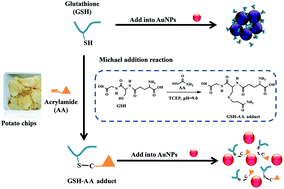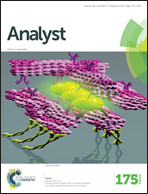A colorimetric detection of acrylamide in potato chips based on nucleophile-initiated thiol–ene Michael addition†
Abstract
Acrylamide (AA), a neurotoxin and a potential carcinogen, has been found in various thermally processed foods such as potato chips, biscuits, and coffee. Simple, cost-effective, and sensitive methods for the rapid detection of AA are needed to ensure food safety. Herein, a novel colorimetric method was proposed for the visual detection of AA based on a nucleophile-initiated thiol–ene Michael addition reaction. Gold nanoparticles (AuNPs) were aggregated by glutathione (GSH) because of a ligand-replacement, accompanied by a color change from red to purple. In the presence of AA, after the thiol–ene Michael addition reaction between GSH and AA with the catalysis of a nucleophile, the sulfhydryl group of GSH was consumed by AA, which hindered the subsequent ligand-replacement and the aggregation of AuNPs. Therefore, the concentration of AA could be determined by the visible color change caused by dispersion/aggregation of AuNPs. This new method showed high sensitivity with a linear range from 0.1 μmol L−1 to 80 μmol L−1 and a detection limit of 28.6 nmol L−1, and especially revealed better selectivity than the fluorescence sensing method reported previously. Moreover, this new method was used to detect AA in potato chips with a satisfactory result in comparison with the standard methods based on chromatography, which indicated that the colorimetric method can be expanded for the rapid detection of AA in thermally processed foods.



 Please wait while we load your content...
Please wait while we load your content...